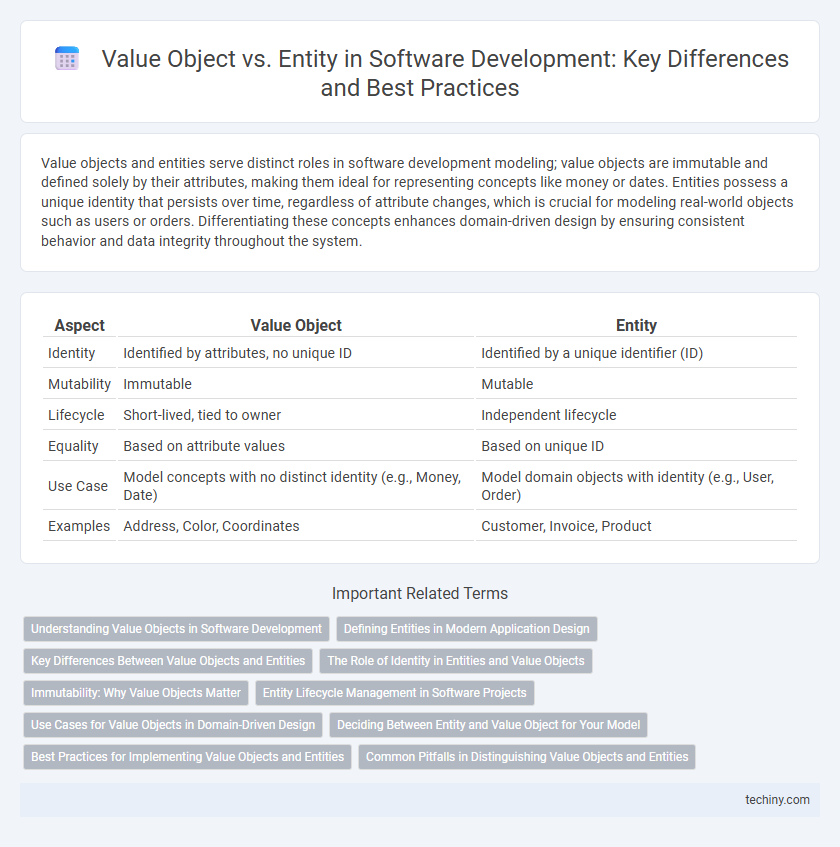Value objects and entities serve distinct roles in software development modeling; value objects are immutable and defined solely by their attributes, making them ideal for representing concepts like money or dates. Entities possess a unique identity that persists over time, regardless of attribute changes, which is crucial for modeling real-world objects such as users or orders. Differentiating these concepts enhances domain-driven design by ensuring consistent behavior and data integrity throughout the system.
Table of Comparison
| Aspect | Value Object | Entity |
|---|---|---|
| Identity | Identified by attributes, no unique ID | Identified by a unique identifier (ID) |
| Mutability | Immutable | Mutable |
| Lifecycle | Short-lived, tied to owner | Independent lifecycle |
| Equality | Based on attribute values | Based on unique ID |
| Use Case | Model concepts with no distinct identity (e.g., Money, Date) | Model domain objects with identity (e.g., User, Order) |
| Examples | Address, Color, Coordinates | Customer, Invoice, Product |
Understanding Value Objects in Software Development
Value Objects in software development represent immutable objects defined solely by their attributes rather than a unique identity, ensuring predictable and consistent behavior across the system. They encapsulate domain-specific concepts such as dates, money, or measurements, promoting code readability and reducing unintended side effects. Leveraging Value Objects enhances domain modeling by simplifying equality comparisons and enabling easier maintenance compared to Entities, which rely on identity for lifecycle management.
Defining Entities in Modern Application Design
Entities in modern application design are distinguished by their unique identity that persists over time, regardless of attribute changes, crucial for representing concepts like users, orders, or products. Unlike value objects, which are defined solely by their attributes and are immutable, entities require explicit identity management and lifecycle tracking within domain-driven design. This focus on identity enables consistent state management and aligns with database primary key strategies, ensuring reliable references across distributed systems and services.
Key Differences Between Value Objects and Entities
Value Objects are immutable data holders defined solely by their attributes, making them ideal for representing descriptive aspects like monetary amounts or dates. Entities possess a unique identity that persists over time, regardless of attribute changes, which is crucial for objects such as users or accounts in software systems. Understanding this distinction ensures proper domain modeling, improving data integrity and system behavior in software development.
The Role of Identity in Entities and Value Objects
Entities are defined by their unique identity, which persists over time regardless of attribute changes, making them essential for tracking and managing business objects in software systems. Value Objects lack distinct identity and are characterized solely by their attributes, promoting immutability and simplifying equality comparisons. Understanding the role of identity helps developers determine when to use Entities for mutable objects requiring consistent identification versus Value Objects for immutable, attribute-driven components in domain modeling.
Immutability: Why Value Objects Matter
Value Objects in software development emphasize immutability, ensuring their state cannot be altered after creation, which enhances predictability and thread safety. Entities differ as they maintain identity through mutable state changes over time, making them suitable for tracking lifecycle and unique identification. Immutability in Value Objects reduces side effects, simplifies debugging, and improves performance in distributed systems.
Entity Lifecycle Management in Software Projects
Entities in software development are uniquely identifiable objects that maintain their continuity and identity throughout their lifecycle, which includes creation, modification, and eventual deletion within the system. Effective entity lifecycle management ensures data integrity and consistency by tracking changes, managing state transitions, and enforcing business rules from inception to termination. Unlike value objects, entities rely on stable identifiers and lifecycle hooks to support complex domain logic and long-term persistence in software projects.
Use Cases for Value Objects in Domain-Driven Design
Value Objects are used in Domain-Driven Design to represent descriptive aspects of the domain with no conceptual identity, ensuring immutability and equality based on their attributes. They are ideal for modeling value-based concepts such as dates, currency amounts, or measurements where identity is irrelevant but state consistency is crucial. Use cases include defining complex data types like addresses or color codes, improving clarity and enforcing domain invariants without the overhead of managing entity lifecycle or identity.
Deciding Between Entity and Value Object for Your Model
When designing a software model, choose an Entity if the object requires a unique identity that persists over time despite attribute changes, such as a user or an order. Opt for a Value Object when immutability and attribute equality define the object, like a date range or a monetary value. Evaluating the domain requirements for identity and lifecycle management guides the decision between Entities and Value Objects effectively.
Best Practices for Implementing Value Objects and Entities
Best practices for implementing Value Objects in software development emphasize immutability and equality based on their attributes rather than identity, ensuring consistent and predictable behavior throughout the application. Entities should be designed with a unique identity that persists across state changes, enabling reliable tracking and management within a domain model. Clear separation of concerns and adherence to domain-driven design principles facilitate maintainable and robust code when distinguishing between Value Objects and Entities.
Common Pitfalls in Distinguishing Value Objects and Entities
Confusing value objects with entities often results in incorrect domain modeling, such as treating immutable value objects as mutable entities, which can cause unintended side effects and data inconsistencies. Overlooking the unique identity of entities leads to improperly managing lifecycle and persistence, impacting application integrity. Misidentifying value objects by assigning them global identity or failing to leverage their immutability reduces code clarity and increases maintenance complexity.
Value Object vs Entity Infographic

 techiny.com
techiny.com